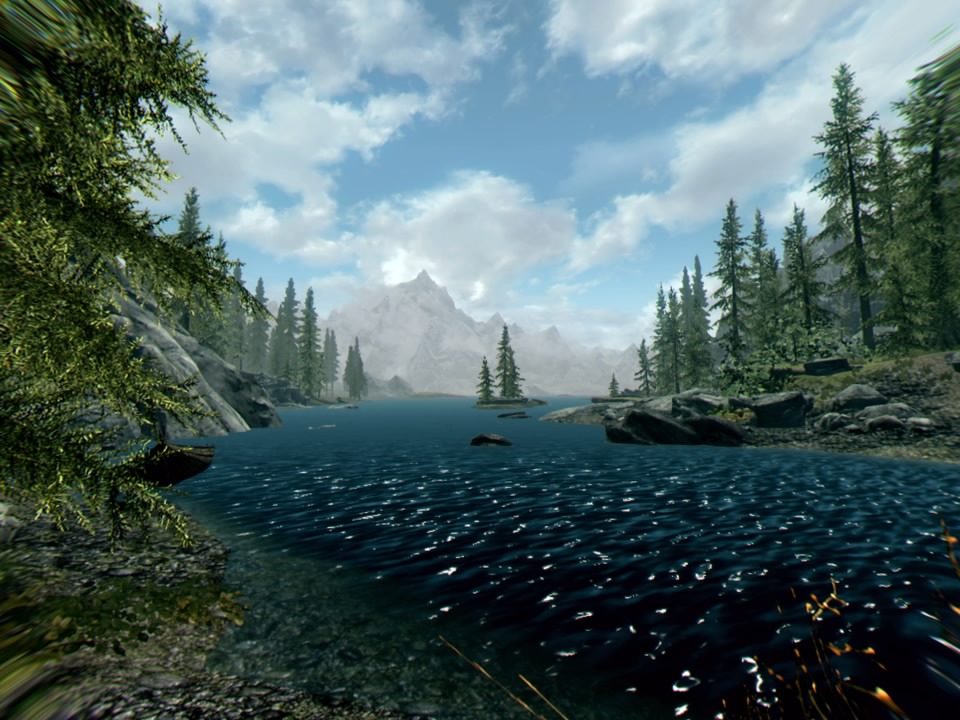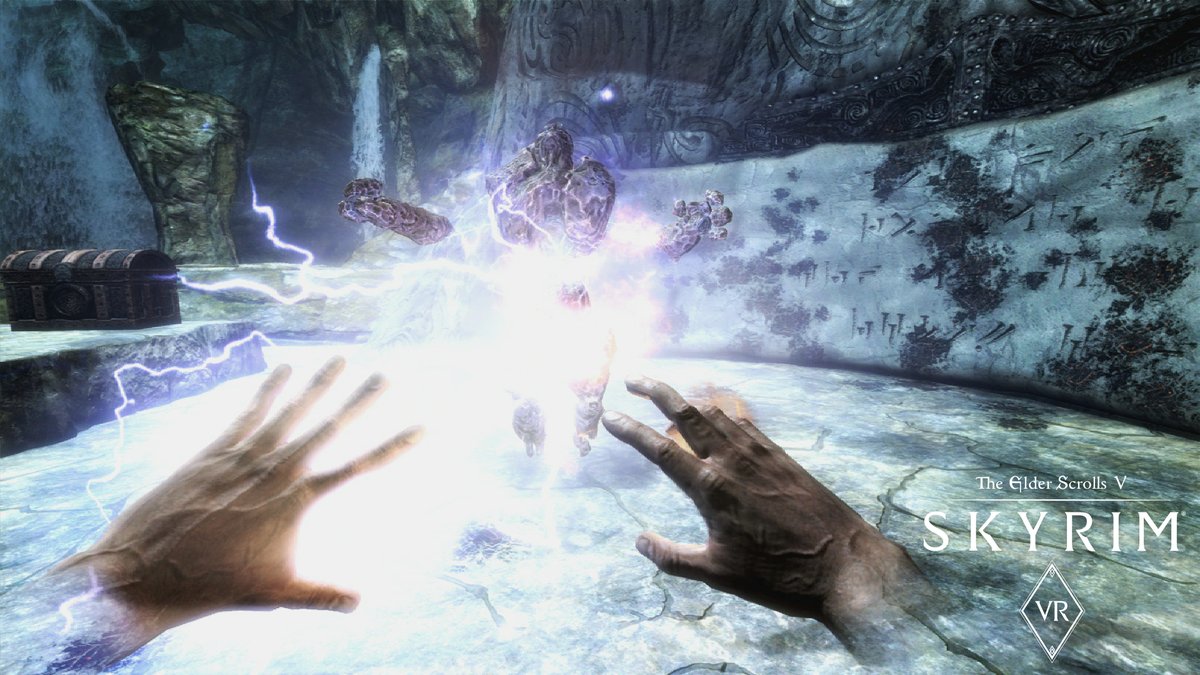Editor’s Note: This is the review for the PSVR VR version of the game so if you’re looking for a review that focuses on the PC VR version (for Rift, Vive, and Windows VR headsets) then you can find that here. The two games are different enough to warrant separate reviews. Here is our Skyrim PC VR review.
Ever since The Elder Scrolls V: Skyrim VR was announced earlier this year back at E3 2017, hungry VR gamers around the world have been impatiently awaiting its arrival. With consumers drowning in a sea of half-finished tech demos and hour-long “experiences” that offer little depth, the arrival of a massive, sprawling adventure is long overdue. Despite the fact that it’s just a VR port of a six-year old game the tantalizing proposition of traveling to the vast, enormous land of Skyrim with the immersive power of virtual reality was just too good to be true. Could a game that massive and interactive really translate over to VR well? Could the PSVR’s Move controllers provide a good enough experience to be worth recommending?
After spending a lot of time with Skyrim VR we finally have the answers to these and many other questions.
Skyrim first released back in 2011 on the PS3, Xbox 360, and PC. Since then it’s received three expansions, an Enhanced Edition update on PC along with a re-release on PS4 and Xbox One, plus a handheld port to Nintendo Switch releasing on November 17th and now Skyrim VR for PSVR releasing that same day. As the winner of over 200 Game of the year Awards according to its packaging, it’s truly the game that keeps on giving.
What makes Skyrim so remarkable is that it iterated on the open world RPG formula Bethesda had been perfecting for years already at that point. Between The Elder Scrolls III: Morrowind, The Elder Scrolls IV: Oblivion, and Fallout 3, Bethesda had a strong foundation to build from. As a result, Skyrim offers nearly endless replayability. Between the 10 races and completely open-ended progression system you’re free to play the game however you want. The core game plus its expansions have hundreds of hours of content for players to devour on any single playthrough.
The main story focuses on a tale of you, the player’s character, donning the role of Dragonborn. What this means is that you’re descended from the once-extinct dragons themselves that have returned to wreak havoc on the world. You’re the last hope against Alduin, the World Eater, and you must learn the langauge of the dragons, wield the thunderous power of their shouts, and become the hero. Well, you could do all of that, or you could just chase butterflies and pick flowers. Or become the leader of the Mage’s Guild. Or settle down, build a house on the river, and get married. Or pretty much whatever you want.
Want to become a sword and shield-wielding fighter that wears heavy armor and bullies his way through the world? Go for it. You’ll level up and earn new skills just by doing the things you want. Hit stuff with your one-handed weapon and that will increase your proficiency with one-handed weapons. The same goes for a bow, shield, spells, and everything else. This means that my Dark Elf wizard that moonlights as a stealthy assassin will play and progress completely differently from your warhammer-toting Orc.
Playing Skyrim is also an exercise in patience, no matter which version you play. Bethesda’s games are so large and unpredictable with countless moving parts that they’re also riddled with bugs. Even now, six years later, there are still bugs in Skyrim to find. Not as many, mind you, but while playing Skyrim VR I did come across wonky animations, objects that were floating instead of being placed on the ground as intended, and just generally lots of models clipping, popping in, and acting weird. It goes with the territory and it doesn’t really impact the experience in any kind of profound way.
For a game this large and full of options I had my doubts that it’d translate to VR smoothly. After my latest hands-on demo where I got the chance to try the smooth locomotion I was more confident, but was still unsure how the final product would fare. Thankfully Bethesda have done a solid job of capturing the vast majority of what makes Skyrim so grand.
The moment when I first blocked an arrow with my shield by raising my left hand up, dashed forward, bashed the bandit by extending my shielded left arm forcefully, then proceeded to slash him several times with full arm swings of the PS Move controller in my right hand to finish him off was when it really hit me: this is Skyrim like I’ve never seen it before.
Pulling back an arrow with my actual hand and loosing it towards an enemy’s face, bashing spiders by swinging downward with a warhammer, or blasting two different enemy’s with the two different spells in my hands are all things I could never do in non-VR Skyrim. I couldn’t turn to look around at the starry night sky or hold my breath as I peek around a corner in a dark cave. It’s in these small, intimate moments that Skyrim’s soul peers out and reminds you why it’s one of the most celebrated games of all-time.
Skyrim VR on PSVR has three control methods: smooth locomotion with the PS Move controllers (referred to as Direct Movement,) teleportation with the PS Move controllers, and direct movement with the Dualshock 4 gamepad. For PS Move direct movement it works by using your left PS Move controller as a sort of guide stick. When you hold down the PS Move button in the middle of the face of the controller you move in the direction that you’re pointing. This lets you move in one direction while still being able to look around with your head — just like you would in real life. Since PSVR is 180-degree tracking only you then must use the X and O buttons on the right PS Move controller to rotate the camera horizontally. You can toggle either snap turning or gradual/smooth turning. Surprisingly the PS Move direct movement with smooth/gradual turning was my preferred control scheme.
After that there’s teleportation locomotion in which you point and click with the PS Move controller. You can’t do any direct/smooth movement with this scheme and you’re forced to blink/teleport across the entirety of the game world. This was my least favorite control scheme, but I could see it being useful for those that suffer severely from motion sickness. Finally you can use just a good ol’ standard Dualshock 4 like you would if you played the non-VR version. The only difference is that you look around with your head and the UI/interactions are all ported to a VR interface. If my arms were tired or I wanted to sit back while playing then this was the method I used.
While I surprisingly had fun with the PS Move method, my gut tells me the Dualshock 4 will be the most popular way of playing. The PS Move controllers aren’t required and not everyone has them, so since the game is fully playable without, there is nothing wrong with playing it this way. In fact, if you do, you can sidestep many of the technical issues that plague the aging PS Move hardware. You lose out on the hand presence but you also gain increased control accuracy and fewer glitches.
In terms of things that have changed for the VR version I wish more care could have been given to the UI. Menus are just floating, flat boxes that you navigate as if you aren’t in VR at all. Subtitles appear the same way and dialog options with NPCs are floating words off to the sides of their heads. It breaks the immersion and it’s unfortunate, but it gets the job done for now. In future large-scale RPGs I’d love for more creative solutions, like a physical backpack instead of an inventory screen. The one exception in which Bethesda did a wonderful job is with the map. It’s a 3D recreation of the entire game world that you can freely fly around in 360-degrees as if you were a giant dragon yourself.
Going in I fully expected to just play Skyrim VR using a Dualshock 4 and call it a day. It’s how I knew the game best from past experiences and that worked just fine for Resident Evil 7, one of the best full VR games released thus far. But I actually found that, despite it all, I really did enjoy using the PS Move controllers. With that being said, they often felt janky and had issues. Sometimes my right hand would tilt to the wrong direction so I’d give it a quick shake and it would realign. Although that’s more of a hardware deficiency than issue with the game. I’d imagine when this releases on PC VR for Vive (and hopefully Rift) next year many of the issues will be ironed out.
One of the biggest gripes I have though with the PS Move controllers is that moving in the heat of battle can be a bit frustrating, but it worked for the most part. Holding up a shield made movement difficult since you can’t point the controller and hold the shield up at the same time. The same goes for drawing back the string of a bow, which requires you to hold the left controller vertically, negating the ability to move around very reasonably. I honestly spent most of my time playing Skyrim VR on Novice and Adept difficulty when using PS Move controllers for this reason. It’s very easy to get overwhelmed by a lot of enemies in VR, particularly when you can’t freely turn in roomscale or move your body very much.

The PS Move controllers still leave a lot to be desired. I’d love to have control sticks like the Oculus Touch so I could just easily move around the world, or the accuracy of the Vive’s lighthouse tracking system so I can freely turn and move around while playing. In the case of PSVR you really have to either stand still, feet planted, or sit down while playing. The single tracking camera isn’t enough to let you move around as much as you’re going to want to. I wanted to side step and dodge attacks more and spin around to hit enemies during the heat of battle, but the PSVR’s limitations are holding the game back. But the fact that I still got lost for hours exploring the same game I’ve played countless times is a testament to the depth of the game.
You can see the effects even more clearly in the visuals. Far off draw distances, like when you first exit Helgen at the end of the intro, look blurry. There’s bad pop-in on some objects like plants and environmental details. Textures like the sides of mountains, buildings, rocks, and the ground all look incredibly flat and plain. Perhaps part of the visual downgrade is because my mind is remembering a fully-modded PC version or the recent PS4 Enhanced Edition, which both outpace Skyrim VR by several miles. Visually what you get with Skyrim VR is more comparable to the original PS3/Xbox 360 release.
The art direction is still fantastic and the world is still living and breathing like nothing else in VR to date, so there’s that, but this is a downgraded port of an already half-decade old game. It’s starting to show some significant blemishes. I’m not going to lie and say Skyrim VR is better than Skyrim outside of VR, because it isn’t. It’s just different. However, I would argue it offers a much more immersive, intimate, and ambitious experience at the loss of visual quality and technical accuracy.
But in many ways Skyrim VR is like a guilty pleasure. It’s ugly compared to its older siblings, it has its share of issues, and in most ways its inferior to its non-VR counterpart, but there is just something special about the sensation of walking down the dirt road to Riverwood in VR for the first time, or staring down the throat of a fire-breathing dragon, or even gazing out upon Tamriel from the top of the Throat of the World. Whether you’re a Skyrim-veteran or one of the lucky few that get to see this world for the first time, Skyrim VR is enrapturing.

For a game that wasn’t originally designed for VR at all and has been ported first to the least powerful of the big three VR platforms in the PSVR, Skyrim VR is nothing short of impressive. This really is the Skyrim that you know and love, but now you can enjoy it like never before with the immersive presence of a VR headset. With a large variety of control schemes to choose from and hundreds of hours of content, this is a game that all RPG fans should play as long as you can look past the sometimes glaring issues. And if you don’t own a PSVR yet, luckily there’s a new Skyrim VR bundle with your name on it.
Update: This review was conducted by testing the game on both a standard PS4 and a PS4 Pro. It was mostly played on a PS4 Pro. Visually it does look better on the Pro, but not by a significant margin. Performance seemed about the same on both consoles.
Read our review of the PC version of Skyrim VR on Rift and Vive right here.
The Elder Scrolls V: Skyrim VR released on PSVR November 17th, 2017 for $59.99. You can also look for it in a bundle with the newly updated PSVR model. For more coverage read our interview with the game’s Lead Producer and our interview with Bethesda’s VP of Marketing. Read our Game Review Guidelines for more information on how we arrive at our review scores.


























